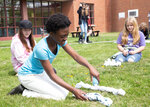Hugh Cole students are ‘Thriving Outside’
Two Hugh Cole 5th grade teachers are showing the potential benefits of incorporating more nature into traditional classroom learning.
This item is available in full to subscribers.
Please log in to continue |
Register to post eventsIf you'd like to post an event to our calendar, you can create a free account by clicking here. Note that free accounts do not have access to our subscriber-only content. |
Day pass subscribers
Are you a day pass subscriber who needs to log in? Click here to continue.
Hugh Cole students are ‘Thriving Outside’
It’s 1:00 p.m. on a Friday at Hugh Cole Elementary, and it’s all smiles for the students in Lynn Palmieri and Ashley O’Blenis’s fifth grade classes.
Sure, there might be some excitement over the impending weekend, but if the scene had taken place on a random Wednesday, it would likely look exactly the same. According to the teachers and the students themselves, it’s no secret why. They were in the midst of a group activity, not happening from within the confines of their classroom, but outside in the warmth under a bright blue sky.
Palmieri and O’Blenis were chosen for a professional development program organized by Thrive Outside, an East Bay-based nonprofit organization dedicated to creating growth opportunities through connection with nature. Their marquee project thus far is a beautiful, dedicated outdoor learning space at Melville Elementary in Portsmouth, but they’ve also helped create a rain garden at Mt. Hope High School and are assisting with another teacher training at Kickemuit Middle School as well. Their 2022 annual report indicates they had conducted training with 65 teachers throughout the state.
The connection to Hugh Cole began a few years prior to Thrive’s involvement, though. Palmieri has been an advocate for outdoor education since she came to Hugh Cole in the midst of the Covid-19 pandemic.
“They were to stay in this little taped off square around their desks, and sit in their seats. They couldn’t move, had to be six feet apart — we actually had like double yard sticks to make sure they stayed six feet apart,” Palmieri recalled. “So as I brought them outside for mask breaks, and you could just see the change in energy, I’m like ‘We’re just going to stay outside.’”
With the blessing of Hugh Cole’s principal and vice principal, Palmieri would take her students outside for at least an hour each day, weather permitting. But as she continued to see the positive impact it had on them, she continued to push for more amenities to boost the outdoor opportunities.
She successfully advocated to get a classroom space this year which had doors leading directly outside. She was able to secure some outdoor desk-chairs, got some picnic tables moved and got workout mats to keep kids off the ground if it was wet (and provide them with a variety of seating options). One day she showed up for work and found that Principal Colin Grimley had procured her a mobile whiteboard with wheels that she could bring outside to help with classroom instruction.
“He’s really gone above and beyond in supporting us,” Palmieri said.
During a visit to their outdoor activity on Friday, Grimley explained why he felt the activity was worthy of supporting.
“It quickly became apparent that the students become more centered and ready to learn,” he said. “It makes them more willing to try things and make mistakes and improve. I know that, personally, I feel more centered after I come out here too.”
O’Blenis agreed that the benefits are easy to see, for adults and children alike.
“I know when I’m feeling stuck or claustrophobic in the classroom, I’m like, ‘I need some fresh air, get me outside.’ And that change in environment really helps those kids take a breath and refocus,” she said. “There’s so many benefits to Vitamin D and natural light, it just really helps brighten your mood.”
Making an impact in the classroom
Palmieri and O’Blenis say that there is already some promising results in mid-year math and science assessments for the kids since Thrive’s involvement began officially this school year. And although more tangible test data will become available at the end of the month to quantify that a bit more, they have both noticed plenty of anecdotal evidence thus far.
“I think it leads to less burnout and more production,” O’Blenis said. “When they sit at their desk all day, by the end of the day they're like, ‘UGH.’ So even just that little break of fresh air while they're working, I know that I'm getting a better turnaround with the work.”
“Last year I had a big component of behavioral issues, and I saw the behavioral issues go down and the work production go up,” Palmieri added.
And while it would ultimately come down to funding and require an effort from the central administration to make it happen, O’Blenis and Palmieri dream of having dedicated learning space set up at Hugh Cole so they can expand their efforts for more kids in the future.
“That's what we're hoping. That’s the end goal,” Palmieri said. “To get a little outdoor space so that we can just walk out and not have to spend the time setting up.”
If you ask the kids, that’s something they’d like to see too.
“I like it because we can get outside and break the day up a little bit more than if we were only in the classroom,” said Kipper Hoberman, sitting at a table working on his project with a couple friends. “It’s relaxing and calming. Like being able to feel the breeze, it’s so nice.”
“Just being out in a green space, I feel like it helps me and my classmates learn,” agreed Daniella Jaja, who set up on the grass beside some friends. “The fresh air and sounds of nature really helps us focus.”













